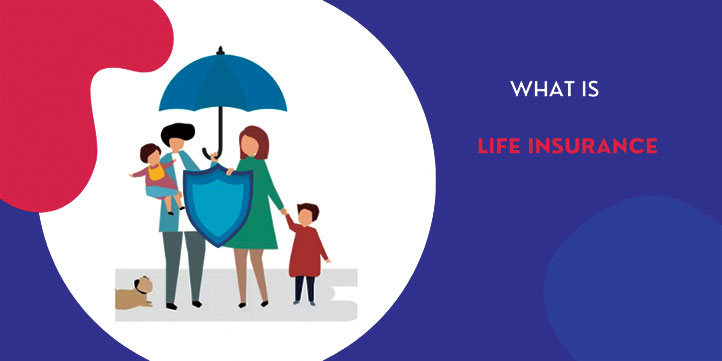What Is Life Insurance, and What Are Its Characteristics

Understanding Life Insurance
Life insurance is a legal agreement between an individual holding an insurance policy and an insurer. In this contract, the insurer commits to providing a designated sum of money to the beneficiary either upon the policyholder’s death or at a predetermined point in time. This exchange is contingent on the payment of premiums by the policyholder.
With life insurance, policyholders are required to make premium payments over a specified term. In return, the life insurance company provides comprehensive coverage to safeguard the financial future of loved ones. If an unfortunate event transpires, a lump sum, known as the death benefit, is disbursed. Additionally, certain policies offer a maturity benefit once the policy term concludes.
One of the main obstacles to the widespread adoption of life insurance is a lack of awareness. The availability of diverse insurance products further complicates matters for some individuals. Nevertheless, most life insurance policies function similarly. Let’s delve into the concept of life insurance and explore how it operates.
Comprehending Life Insurance Policies
Life insurance is essentially a binding contract wherein the policyholder pays regular premiums to maintain coverage. This coverage extends financial protection from the insurance company, ensuring a death benefit is granted to the nominee in the event of the policyholder’s demise. To keep the policy in force, the policyholder must consistently fulfill their premium obligations.
In essence, the benefits associated with a life insurance policy are intrinsically linked to the payment of premiums. As a result, it’s crucial to select a premium that can be conveniently managed. A life insurance policy remains effective only if all premiums are diligently paid.
Now that we’ve clarified the essence of life insurance policies, let’s explore how they function.
The mechanics of a life insurance policy
Life insurance operates as a legally binding contract wherein individuals pay a relatively small premium to secure a substantial sum of protection. In the unfortunate event of the policyholder’s untimely demise, the insurer disburses the substantial sum to the policyholder’s family or dependents.
Typically, life insurance policies have a limited duration. Consequently, if the policyholder passes away during this period, the life insurer is obligated to provide the death benefit, also referred to as the sum assured. However, should the policyholder survive the term, they may be eligible for a maturity benefit, the nature of which depends on the specific policy.
Whole life insurance plans tend to emphasize the death benefit over the maturity benefit.

Illustrating with an Example
Let’s consider an example: Mr. Shah acquires a life insurance policy from Canara HSBC Life Insurance. This 20-year policy boasts a sum assured of Rs 10 lakh and entails an annual premium of Rs 25,000 payable over the course of 20 years, equating the premium payment term to the policy term.
The sum assured of the policy also functions as the maturity benefit if Mr. Shah successfully completes the policy term. Here’s how this life insurance policy plays out for Mr. Shah:
Scenario 1: Mr. Shah Completes the Policy Term
Total premiums paid by Mr. Shah amount to Rs 5 lakhs.He receives a maturity benefit of Rs 10 lakh, possibly accompanied by a bonus.The policy concludes after disbursing the maturity benefit.Scenario 2: Mr. Shah Passes Away in the 10th Policy Year
Mr. Shah has paid Rs 2.5 lakh in premiums for life insurance.His nominees receive a total of Rs 10 lakhs along with any applicable bonus in the 10th policy year.The policy terminates after delivering the death benefit.Scenario 3: Mr. Shah chooses premium protection
Upon Mr. Shah’s demise in the 10th year, the policy disburses the death benefit of 10 lakhs as usual to his family.The policy continues to accumulate investment value.Ultimately, it pays the promised maturity value of Rs 10 lakhs along with any applicable bonus at the end of the 20-year policy term.Benefits of Life Insurance Plans
Life insurance plans are long-term investment and protection arrangements laden with a multitude of advantages.
Some of the most notable benefits include:
Financial Protection: Life insurance ensures financial security for your family. In the event of your demise during the policy term, a predetermined sum, known as the sum assured, is provided to your family, granting them financial stability.
Cultivating a Savings Habit: Regular premium payments are necessary to maintain an active life insurance policy. This routine instills a saving habit, which can be highly beneficial in the long run.
Tax-Savings: Life insurance is a tax-efficient investment. Under Section 80C of the Income Tax Act 1961, you can avail a tax deduction of up to Rs 1.5 lakhs on the premium you pay each year.
Achieving Financial Goals: Some life insurance policies accumulate cash value over time, particularly ULIPs. These policies invest your premium in marketable securities, generating returns that can be used to fulfill significant financial goals, such as your child’s education or a carefree retirement.
Wealth Protection and Distribution: Life insurance plans serve as secure long-term investment options. They help preserve your wealth against the erosive effects of tax and inflation, making them a valuable instrument for retired individuals seeking a stable source of pension.

Varieties of Life Insurance Plans in India
Now that we’ve explored what a life insurance policy entails, it’s time to delve into the diverse types of life insurance policies available in India. Your choice should align with your financial objectives when selecting the ideal life insurance plan.
Here are the various types of life insurance plans at your disposal:
Term Life Insurance Plan: This type of insurance covers a specific period and expires at the term’s conclusion. Term plans are appealing due to their affordability, making them accessible for individuals embarking on their careers. Certain term life insurance plans encompass critical or terminal illness coverage, offering a lump-sum payout for life-threatening conditions to assist with medical expenses.
Whole Life Insurance Plan: As the name implies, this policy provides coverage until the age of 99. It combines a death benefit with a cash value. The cash value grows over time and can be withdrawn by the policyholder once it reaches a certain threshold, or it can be accessed through a loan against the policy.
Unit-Linked Insurance Plans (ULIPs): ULIPs are hybrid investment and insurance policies, offering both life coverage and investment opportunities. Most ULIPs have a lock-in period of 5 years, making them suitable for long-term investing. However, they are influenced by market dynamics, so understanding your risk tolerance is vital when considering a ULIP.
Endowment/Saving Plans: These policies combine life coverage with a savings component. Opting for a suitable savings plan allows you to save consistently over time, leading to a lump-sum payout upon maturity. Endowment or savings plans are beneficial for those with long-term financial objectives, such as funding their child’s education, purchasing a new home, or enjoying a worry-free retirement.
Money Back Policy: Money back policies disburse partial sums of the sum assured at regular intervals during the policy’s term. These plans provide survival benefits paid out during the policy’s tenure and at maturity. In the event of the policyholder’s demise while the policy is active, the entire sum assured is given to the beneficiaries, regardless of the previously paid survival benefits.
Child Insurance Plan: These policies are designed to secure the future of your child. In addition to providing life coverage, they help build an education fund to support your child’s aspirations. Child insurance plans encompass investment and insurance features, enabling you to establish a robust financial foundation for your child from a young age.
Retirement Plans: These life insurance policies assist in accumulating a retirement corpus, ensuring financial security during your post-retirement years. By nominating your spouse as the plan’s beneficiary, you guarantee their financial independence in the event of your demise. Moreover, a well-chosen life insurance plan can help cover medical expenses during retirement.
Purchasing a Life Insurance Policy Online
Understanding what a life insurance policy entails and how it functions is essential, but so is the process of purchasing such a policy. Buying life insurance has become more convenient over time, thanks to online channels that facilitate the acquisition of policies with minimal hassle. In India, the application process for a life insurance plan is straightforward. You can visit the nearest branch of an insurance company or opt for the convenience of purchasing a life insurance plan online. Canara HSBC Life Insurance has streamlined its operations, making it possible to forego excessive paperwork and buy a policy from the comfort of your home. The insurance company verifies the details provided by the applicant before issuing a policy, which may include a medical examination if necessary.
In the past, life insurance policies could only be obtained through agents offline. However, technological advancements have made it possible to purchase insurance online with just a few clicks.
Here are the steps you can follow to acquire insurance online:
Log in to the website. Visit the website’s home page.Browse available life insurance options: Explore the variety of life insurance plans offered.Calculate your premium. Utilize the ‘check premium’ button to estimate your premium after inputting relevant details.Complete the application form. Fill in your basic information within the provided form.Undergo medical tests (if necessary): Be prepared for medical examinations, if they are deemed necessary.Premium payment: Choose your preferred payment method, whether through credit card, debit card, net banking, and so on.Verification and policy issuance: After scrutinizing your information, the policy will be issued.
Selecting the Right Life Insurance Policy
Understanding the concept of a life insurance policy is just the beginning. It’s crucial to determine which type of life insurance policy suits your needs. In addition to assessing the required coverage, you must identify the most suitable plan based on two key considerations:
Duration of Coverage: Decide how long you want your life insurance coverage to last.Financial Goals: Determine which financial objectives take precedence for you.Answering these questions will guide you in selecting the most appropriate policy.
Filing a Life Insurance Claim after the Policyholder’s Death
In the unfortunate event of the policyholder’s untimely demise, the insurance company disburses the sum assured to the designated nominee. The claims process is straightforward: notify the insurance company as soon as possible following the policyholder’s death. The nominee must complete a claims form and submit it along with the required documents, including the death certificate. The insurance company verifies the claim and releases the benefit. In some instances, further examination may be necessary, requiring additional documents and slightly prolonging the claim settlement. Claims can be paid in a lump sum or through regular monthly installments, allowing flexibility in how the beneficiaries receive the death benefit. As a beneficiary, follow these three steps to file a claim in the event of the policyholder’s demise:
Provide the Death Certificate: Submit a copy of the policyholder’s death certificate when initiating the claim process. It’s advisable to have a certified copy ready to expedite the process.
Contact the insurer: Notify the life insurance company promptly, as starting the process sooner is generally more advantageous.
Document Preparation: Gather all necessary documents, including the claim form, before initiating the claim process.
Do I Need a Life Insurance Plan?
Yes, life insurance policies offer assurance for your loved ones. Acquiring the best life insurance policy can provide critical financial support in case of an unforeseen event. This coverage extends to accidental death, permanent and temporary disability, and child support.
You should consider a life insurance plan if:
a) You are married.b) You have children.c) You are unmarried.
Whether you are single, married, or have children, a life insurance plan provides a safeguard. If your family relies on your financial support, it’s advisable to explore the best life insurance plans. With escalating educational costs, establishing an education fund from the outset is essential for securing your child’s future. Furthermore, even for single individuals, unexpected expenses can arise, necessitating financial preparedness.





